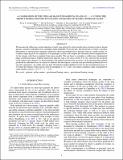| dc.contributor.author | Schechter, Paul L. | |
| dc.contributor.author | Pooley, David | |
| dc.contributor.author | Blackburne, Jeffrey A. | |
| dc.contributor.author | Wambsganss, Joachim | |
| dc.date.accessioned | 2015-01-16T19:52:26Z | |
| dc.date.available | 2015-01-16T19:52:26Z | |
| dc.date.issued | 2014-10 | |
| dc.date.submitted | 2014-04 | |
| dc.identifier.issn | 0004-637X | |
| dc.identifier.issn | 1538-4357 | |
| dc.identifier.uri | http://hdl.handle.net/1721.1/92950 | |
| dc.description.abstract | We measure the stellar mass surface densities of early-type galaxies by observing the micro-lensing of macro-lensed quasars caused by individual stars, including stellar remnants, brown dwarfs, and red dwarfs too faint to produce photometric or spectroscopic signatures. Instead of observing multiple micro-lensing events in a single system, we combine single-epoch X-ray snapshots of 10 quadruple systems, and compare the measured relative magnifications for the images with those computed from macro-models. We use these to normalize a stellar mass fundamental plane constructed using a Salpeter initial mass function with a low-mass cutoff of 0.1 M ☉ and treat the zeropoint of the surface mass density as a free parameter. Our method measures the graininess of the gravitational potential produced by individual stars, in contrast to methods that decompose a smooth total gravitational potential into two smooth components, one stellar and one dark. We find the median likelihood value for the normalization factor F by which the Salpeter stellar masses must be multiplied is 1.23, with a one sigma confidence range, dominated by small number statistics, of 0.77 < F < 2.10. | en_US |
| dc.description.sponsorship | National Science Foundation (U.S.) (NSF grant AST 02-06010) | en_US |
| dc.description.sponsorship | National Science Foundation (U.S.) (NSF grant AST 06-07601) | en_US |
| dc.description.sponsorship | United States. National Aeronautics and Space Administration (NASA Chandra grant GO7-8099) | en_US |
| dc.description.sponsorship | Williams College | en_US |
| dc.description.sponsorship | United States. National Aeronautics and Space Administration (Chandra grant GO1-12135) | en_US |
| dc.description.sponsorship | United States. National Aeronautics and Space Administration (Chandra grant GO3-14102) | en_US |
| dc.language.iso | en_US | |
| dc.publisher | Institute of Physics/American Astronomical Society | en_US |
| dc.relation.isversionof | http://dx.doi.org/10.1088/0004-637X/793/2/96 | en_US |
| dc.rights | Article is made available in accordance with the publisher's policy and may be subject to US copyright law. Please refer to the publisher's site for terms of use. | en_US |
| dc.source | American Astronomical Society | en_US |
| dc.title | A CALIBRATION OF THE STELLAR MASS FUNDAMENTAL PLANE AT z ∼ 0.5 USING THE MICRO-LENSING-INDUCED FLUX RATIO ANOMALIES OF MACRO-LENSED QUASARS | en_US |
| dc.type | Article | en_US |
| dc.identifier.citation | Schechter, Paul L., David Pooley, Jeffrey A. Blackburne, and Joachim Wambsganss. “ A CALIBRATION OF THE STELLAR MASS FUNDAMENTAL PLANE AT z ∼ 0.5 USING THE MICRO-LENSING-INDUCED FLUX RATIO ANOMALIES OF MACRO-LENSED QUASARS.” The Astrophysical Journal 793, no. 2 (September 11, 2014): 96. © 2014 American Astronomical Society. | en_US |
| dc.contributor.department | Massachusetts Institute of Technology. Department of Physics | en_US |
| dc.contributor.department | MIT Kavli Institute for Astrophysics and Space Research | en_US |
| dc.contributor.mitauthor | Schechter, Paul L. | en_US |
| dc.relation.journal | Astrophysical Journal | en_US |
| dc.eprint.version | Final published version | en_US |
| dc.type.uri | http://purl.org/eprint/type/JournalArticle | en_US |
| eprint.status | http://purl.org/eprint/status/PeerReviewed | en_US |
| dspace.orderedauthors | Schechter, Paul L.; Pooley, David; Blackburne, Jeffrey A.; Wambsganss, Joachim | en_US |
| dc.identifier.orcid | https://orcid.org/0000-0002-5665-4172 | |
| mit.license | PUBLISHER_POLICY | en_US |
| mit.metadata.status | Complete | |
